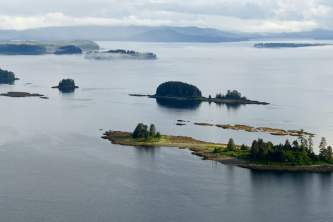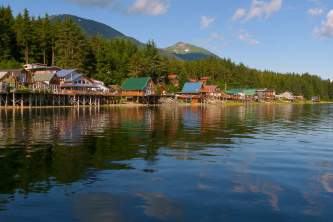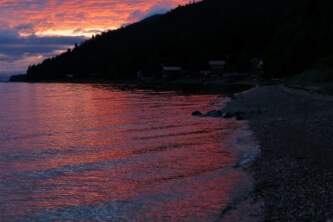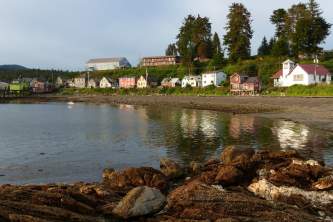Where to Take your Photo in Nome
Nome is full of history and great photo-ops. A mining town that is also the end of the famed Iditarod Sled Dog Race, Nome also offers striking natural features like Anvil Rock and the Bering Sea. Here’s our list of popular sites to visit for your own photo collection.
Welcome to Nome sign # 1
A carved sign depicting Nome as the “Crossroads of History, Cultures and Continents” greets visitors on the way into town from the airport. Old gold dredge buckets decorate its base. Watch for it on the right side of Seppala Drive, along the Snake River.
Welcome to Nome sign #2
Stop at the weathered and carved “Welcome to the City of Nome” display. In the back, the artist carved, “Nome. A part of my heart remains here.” (top of the seawall, near the beach, behind the Visitors Center)
Anvil City Square
This is probably the most popular spot in Nome for visitor photos, and you can get one with life-sized statues of the “Three Lucky Swedes,” an 18-foot high gold pan (that also says “Welcome to Nome”), and Anvil Rock in the background. Statues of the young boys who helped the lucky miners find gold, a display of Native umiak boat frames, and historic Old St. Joe’s Hall will fill out the memory card on your camera.
Nome Beach/Bering Sea
The dramatic Bering Sea is always photo-worthy, whether it’s in winter’s frozen grip, or whether its waves are crashing ashore. The famous beaches of Nome, where gold was discovered right in its sands, has both historic and picturesque photo value.
Burled Arch
You, too, can cross the Iditarod finish line, even in summer. Find the iconic burled arch near Nome City Hall until March, when it is moved to dominate the west end of Front Street, waiting for mushers to arrive in the Iditarod Finish Chute. (101 Division St.)
Original Burled Arch
The first burled arch, which was used at the Iditarod finish line from 1975 to 1999, fell apart as it was being moved after the 1999 race was over. It has been put back together and is on display in the Nome Rec Center.
Site of Wyatt Earp’s Dexter Saloon
Wyatt Earp, the lawman from OK Corral shootout fame, came to Nome during the gold rush years to “mine the miners,” as he said. He and his wife operated a saloon here for a time, leaving with a reported $80,000. While the Dexter Saloon is long gone, the city has marked the site by building Nome City Hall right on top of it! (101 Division St.)
Anvil Rock
The giant tor formation on the top of the mountain near Nome looked like a blacksmith’s anvil to early miners, and so the naming began: Anvil Rock, Anvil Mountain, Anvil Creek…Nome was even called Anvil City for a time. You can get a photo from lower elevations, or hike or drive right up to the rock.
The View from Anvil Mountain
It’s an amazing view of Nome and the Bering Sea from atop Anvil Mountain, and it’s well worth the time to drive or hike up.
White Alice Site
These are the last remaining antennas from a Cold War communications relay system designed to warn the U.S. about any missiles headed our way from the nearby Soviet Union. Close to Anvil Rock, with a view of the city below, so you can get three photos in one trip.
Swanberg Dredge
Massive digging machines, gold dredges crunched over the land, scooping up material to make gold extraction easier – and leaving a changed landscape in their path. The dredges were abandoned after the gold rush and are historic markers for visitors to find and wonder over. The Swanberg Dredge, on the East end of town, is one of dozens remaining on the Seward Peninsula.
Last Train to Nowhere
It’s probably the most intriguing photo you can capture on your visit: the three stranded train locomotives rusting on the coastal plain near Solomon. Originally part of New York’s elevated train line, the locomotives were brought to Alaska in the early 1900s as part of a grand scheme to connect the remote areas of the Seward Peninsula by rail. That plan was first derailed by a lack of funding, and then by a huge storm, which destroyed the terminal and some track – leaving these locomotives behind as a surreal historical landmark.




